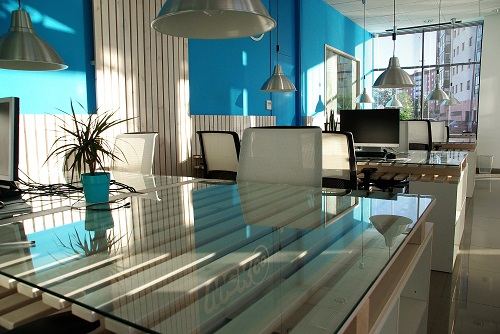A mandatory requirement for implementing an effective, flexible office is the ability to use occupancy analytics.

David Rottelman,
Global VP of Sales,
PointGrab
|
April 2018 |
[an error occurred while processing this directive] |
| Sensing Solutions for the
Flexible Workspace A mandatory requirement for implementing an effective, flexible office is the ability to use occupancy analytics. |
 David Rottelman, Global VP of Sales, PointGrab |
| Articles |
| Interviews |
| Releases |
| New Products |
| Reviews |
| [an error occurred while processing this directive] |
| Editorial |
| Events |
| Sponsors |
| Site Search |
| Newsletters |
| [an error occurred while processing this directive] |
| Archives |
| Past Issues |
| Home |
| Editors |
| eDucation |
| [an error occurred while processing this directive] |
| Training |
| Links |
| Software |
| Subscribe |
| [an error occurred while processing this directive]
|
Overview
With the increase of
workforce mobility and the growing trend of de-centralized and
team-based work, companies realize that the traditional workplace needs
to evolve to support these changes. The dynamic nature of contemporary
work often requires ad hoc collaborative teams that need greater
workspace flexibility. Furthermore, about 40% to 50% of current office
space is underutilized, leading to a substantial waste of operational
expenditures. Companies are therefore looking for a flexible workplace
where the office space is optimized, and employees are given greater
flexibility to choose where, when and how they work.
The use of sensing technologies provides facility managers with
organizational insights to help optimize the workspace. There are a
variety of sensing technologies to choose from, but the technology
choice largely depends on the primary use cases to be supported.
Flexible Workspace Use Cases
The
use cases for the flexible office are many. Primary examples include:
Occupancy Analytics
A mandatory requirement for implementing an effective, flexible office
is the ability to use occupancy analytics. Captured by sensors across
the building space, occupancy analytics data provides facility managers
with accurate, real-time and reliable information about workplace
occupants’ locations to understand and address usage needs.
Key Requirements
There are several types of sensors in the market that are currently
used for attempting occupancy analytics, and each employs different
technologies. From a systemic point of view, all types must address the
stringent requirements of cybersecurity and should easily integrate
with various ecosystems. From the aspect of pure sensing functionality,
the following are the key requirements for sensing in the flexible
workspace:
Privacy-based, Non-intrusive and Anonymous – Highly accurate and rich occupant tracking data can potentially infringe on occupants’ privacy. A sensing solution that provides anonymous data is therefore imperative.
Extendable and Future-proof – A sensor network installed across the building space should be reliable and operate for several years. Updating the sensors over the air (OTA) with improvements, critical fixes, and enhanced feature-sets is mandatory for an enduring life cycle.
Scalability – Networked sensors
must have the ability to incorporate into modular solutions so that a
customer’s deployment can easily scale up from rooms to floors to
buildings.
Current
Sensing Solutions
 Companies
that are planning to adopt the flexible workplace model
should first make a decision about the occupancy sensing solution that
will be used in their facility management system. This is a critical
decision since it determines the type of data provided by the sensor
and hence which use cases can be supported. Three types of sensing
methods are frequently considered for this purpose: motion detectors,
wireless micro-location solutions, and IP cameras.
Companies
that are planning to adopt the flexible workplace model
should first make a decision about the occupancy sensing solution that
will be used in their facility management system. This is a critical
decision since it determines the type of data provided by the sensor
and hence which use cases can be supported. Three types of sensing
methods are frequently considered for this purpose: motion detectors,
wireless micro-location solutions, and IP cameras.
Motion
detectors, typically passive infrared (PIR) devices, are used in
office buildings for two main applications: saving lighting energy and
reducing workspace via hot desking, usually by attaching the sensors
underneath desks. In general, motion detectors are basically presence
detectors and are inherently limited in providing the data granularity
that is required for locating, counting and tracking occupants. Motion
detector functionality is therefore restricted to a handful of specific
use cases. While this sensing solution can easily scale up, it is not
future proof as the individual sensor’s processing power is extremely
limited. Finally, using PIR sensors for hot desking turns out to be
rather expensive.
Wireless
micro-location solutions include a variety of technologies
such as Wi-Fi, Bluetooth, RFID, GPS, VLC, iBeacon and more. These
wireless methods actually track devices, not people, and require the
constant carrying of mobile devices/tags by the occupants. They also
frequently require occupants to opt-in to the system. The accuracy of
this solution is limited, and it may not be practical for occupancy
analytics in an office environment where employees often move around
without their mobile devices, have more than one device, or simply run
out of battery. More importantly, tracking occupants through personal
devices may infringe on individual privacy. On the other hand, wireless
micro-location solutions are advantageous for special use cases such as
indoor navigation.
IP
cameras are powerful sensors that are typically used for security
purposes but can nevertheless gather highly valuable information about
space usage in the facility. However, applying them for tracking
occupants is very costly and has some additional shortcomings, such as
network traffic overload and difficulty to scale up. Even more
importantly, they are perceived as compromising privacy.
Image-Based Smart Sensors
An
emerging sensing solution, based on image sensors, provides highly
accurate and detailed information about occupants’ whereabouts at a
lower cost while protecting privacy. Using ceiling mounted image-based
sensors with edge-analytics processing capability, these sensors
deliver unprecedented data on occupants’ presence, location, count, and
movement. As edge analytics devices, all processing is performed at the
sensor level and images for analytics are processed, not stored or
transmitted, ensuring occupants’ privacy is protected. Having
sufficient on-sensor processing power and connectivity, they can
support remote upgrades. Finally, these sensors’ underlying computer
vision capability allows for object detection beyond occupant location
(e.g., desks, computers, doors, chairs, and the like), making room for
substantial future growth and support for additional important use
cases.
The
following comparative table illustrates the advantages and
disadvantages of the various sensor types:
[an error occurred while processing this directive]Summary
As the flexible workplace is becoming a global trend, it is clear that adapting to this new working environment largely depends on advanced technologies to capture information on how the workspace is being used. Traditional sensing solutions are abundant but only partially address the needs of the flexible workplace. Image-based smart sensors that perform onboard occupancy analytics and provide highly accurate but anonymous data are emerging as key enablers for the flexible workplace. Forward-looking facility managers should pay attention to this new type of smart sensors.
About The Author
David Rottelman has over 20 years of managerial experience in the
high-tech industry and is currently the Global VP of Sales for
PointGrab, a leader in facility management sensing solutions.
Prior
to joining PointGrab, David was VP of Sales, EMEA, at Cloudify, where
he grew the region’s revenues into a significant and sustainable
percentage of company sales. Prior
to Cloudify, David spent 16 years at Starhome Mach, a provider of
global roaming and IoT connectivity solutions, in a number of
positions, including project manager for the company’s first customer
deployments. As VP of Sales, Europe, in his final role at Starhome
Mach, David consistently demonstrated strong sales leadership,
while doubling the revenue in this territory. David holds a B.Sc.
in Electrical Engineering from Tel-Aviv University
and M.Sc. in Industrial Engineering from the Ben-Gurion University of
the
Negev.
[an error occurred while processing this directive]
[Click Banner To Learn More]
[Home Page] [The Automator] [About] [Subscribe ] [Contact Us]